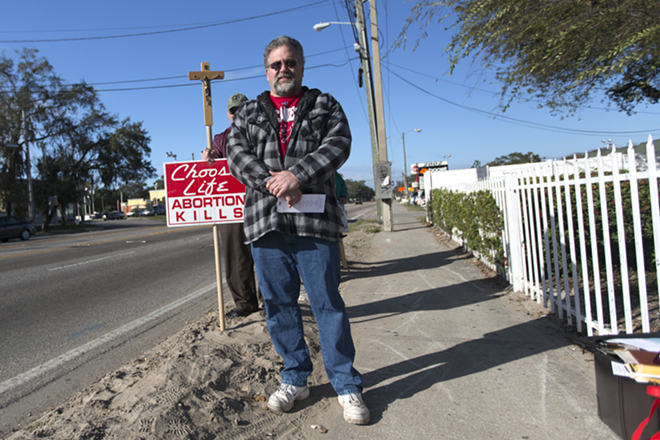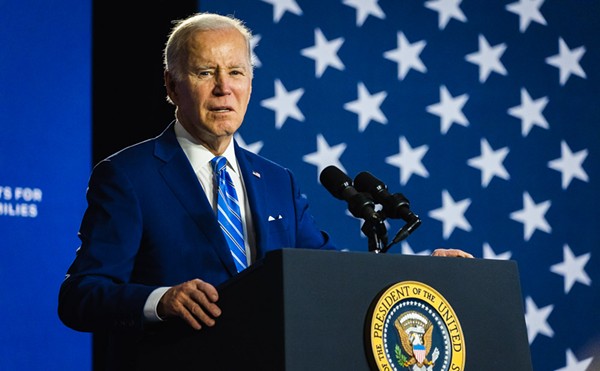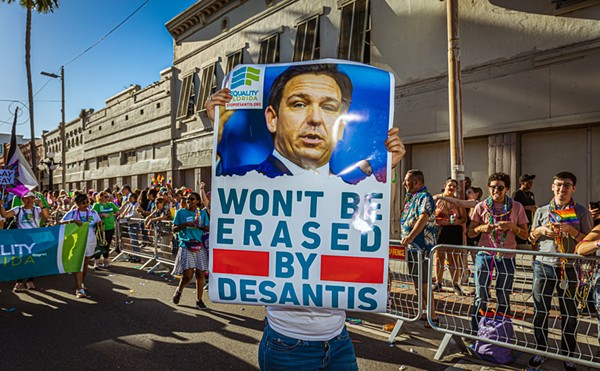
“Choose life,” urges Jim Haskins’ sign, which is attached to a large wooden crucifix. “Abortion kills.”
On the Saturday morning before the 40th anniversary of Roe v. Wade, the landmark Supreme Court decision granting women access to abortions under federal law, five pro-life activists stand in front of the Tampa Woman’s Health Center on Fletcher Avenue in North Tampa.
“You see all the vultures?” Haskins says, pointing across the street at two large black birds perched in a tree. “There are usually hundreds here.”
Health center staffers haven’t noticed any large flocks of predatory birds in the vicinity. But they do have to contend with another kind of regular visitor: self-styled “sidewalk counselors” like Haskins who come from faith-based organizations every Saturday to proselytize at area clinics from Largo to South Tampa, rain or shine.
Protesters are hardly the biggest obstacles standing in the way of women seeking abortions. The last two years have seen anti-abortion measures passed in record numbers across the country, and the number of abortion providers is decreasing.
The pro-choice activists who successfully fought Florida’s proposed Amendment 6 last fall saw their campaign as a needed wake-up call. Still, the subject of abortion remains, even four decades after Roe, fraught with mixed emotions.
“It’s seen as so shameful instead of a common experience among women,” says Jennifer Ellerman-Queen, women’s studies professor at the University of South Florida. “We don’t talk about it. We’ve got to open up a dialogue.”
Chris Gladu, a jovial-looking middle-aged man with a thick salt-and-pepper beard, has been spending his Saturdays outside abortion clinics for 20 years. He comes equipped with a Bible, a carafe of hot coffee, and a small velvet-lined wooden box in which he displays plastic models of fetal development.
“We are driven by love,” Gladu said. “We are here to save the babies and save the mothers from a lot of pain.”
Women walk hurriedly toward the door, some with friends and family, some alone, some with their partners. Gladu, standing on the sidewalk outside the clinic fence, tries to reach over and hand them pamphlets.
“Women don’t have abortions to be empowered, they do it because they feel trapped,” Gladu said. “I think it is wrong to pit the interests of the woman against the child and let the other person go on intact.”
One in every three American women will have an abortion by the age of 45, according to the Guttmacher Institute, which studies sexual and reproductive health. Fifty-eight percent of those women will have the procedure while in their 20s. In 2008, Florida represented 7.8 percent of all of the abortions undertaken nationwide. Of the 381,500 pregnancies statewide that year, 25 percent resulted in abortions; that’s about 27 abortions for every thousand women.
At the same time, legislators have attempted to make access to abortion more and more difficult. Many pro-choice advocates say that the chipping away of abortion rights can be traced back to the 1992 Supreme Court case Planned Parenthood v. Casey, which upheld the right to an abortion but expanded the ability for states to enact all but extreme restrictions on women’s access. “They can uphold a decision that makes it nearly impossible for women to get the procedure,” says Kellie Dupree, vice president of public policy and communications at Planned Parenthood of Southwest and Central Florida.
In 2011, 42 states and the District of Columbia passed 92 abortion restrictions, the highest number ever. The numbers decreased in 2012 — only 24 passed in just six states.
“Last year there were four bills specific to abortion and several others attempting to inhibit a women’s right to choose,” Tampa area House Democrat Janet Cruz said.
Restrictions that have gone into effect in the state this month include mandatory pre-abortion ultrasounds and a 24-hour waiting period.
“And we’re not talking jelly-on-the-belly ultrasounds,” says Ellerman-Queen. “We’re talking about a transvaginal ultrasound. It’s not comfortable. To have to be forced to look at this, regardless of the point in pregnancy, is traumatizing.”
Providers are also required to ask women if they’d like to see the fetus.
“Generally the argument across the country is if a woman has an ultrasound, she is more likely to change her mind about abortion,” says Planned Parenthood’s Dupree. “We don’t think laws imposed to shame women are best for a woman’s health.”
Additionally, minors must notify parents 48 hours before an abortion. Public funding for an abortion is available only in cases of rape or incest, or if a physician determines the woman’s life is in danger.
Meanwhile, no new laws were passed in the state to improve access to family planning or comprehensive sex education.
Gladu acknowledges that he doesn’t often get his message across.
“By the time they get here, they’ve mentally aborted the child,” Gladu says. “Some are open to being talked out of it. It’s a mixed bag.”
He calls out to a man following a woman into the clinic.
“Can you give her this? It has information on pregnancy centers and options,” Gladu asks.
“It’s not my choice,” the man replies, taking Gladu’s pamphlet.
The “pregnancy centers” promoted by Gladu are funded almost exclusively by faith-based organizations. Billboards for the centers are familiar sights along area highways, advertising free ultrasounds or free pregnancy tests (but never, of course, abortion).
“Generally we think pregnancy centers are misrepresenting themselves as healthcare providers,” says Dupree. “Often, they provide medically inaccurate information.”
But the centers’ numbers are increasing. In January, the New York Times reported there are 2,500 pregnancy centers nationwide compared to 1,800 abortion providers. There are 91 abortion providers in Florida, down 12 percent from 2005; 72 percent of counties have no abortion providers at all. One in four women live in those counties.
“Overall, the amount of doctors taking on this role decreases every year,” Dupree said. “It’s not very popular in medical school, and the number of doctors doing it are lessening.”
Finding an abortion provider is only the first hurdle; paying for it can be even more of a challenge.
According to Guttmacher, 42 percent of women seeking abortions live at or below the poverty line. That means they often rely on government healthcare, which does include contraception but does not cover abortion.
“You’re a young woman living on the edge of poverty and all of a sudden you have to pay for an abortion too,” Ellerman said. “Is it less expensive to pay for an abortion than to have a child on welfare for the rest of their lives?”
If you’ve had unprotected sex and are concerned about getting pregnant, the Plan B pill is available without a prescription for women 17 and older for $35-$60. Taken in the first 72 hours following intercourse, it can prevent pregnancy. After that, it gets a little more complicated and much more expensive.
A medical abortion is available for pregnancies nine weeks or less and involves taking the “abortion pill” by mouth, costing $300-$800. Before taking the pill, women must submit to an ultrasound (sometimes at their own cost), wait 24 hours, and then return to get the pill. It is considered the least invasive of abortion procedures.
Of the abortions performed nationwide in 2008, 88 percent were performed in the first 12 weeks. After nine weeks until 24 weeks, surgical abortions are available. But past the first trimester, there are few clinics that offer services.
Planned Parenthood’s new motto is “care no matter what,” and Dupree says they have help for those in financial need.
The vote to reject Amendment 6 represented a rare victory for pro-choice forces in Florida. For Ayele Hunt, executive director of I Am Choice, the group formed to fight the amendment, the fight was personal — a chance to carry on the legacy of those who fought for Roe.
“I felt like we young women let the ball drop,” Hunt said. “A lot of my dedication to this issue came from a feeling of being obligated to them, to what those women fought for.”
The amendment, proposed by the state Legislature, was viewed by opponents as a veiled threat to women’s rights to privacy, a means of laying the groundwork for abolishing abortion in the state altogether.
But getting the message across was a challenge, says Hunt.
“One lesson I took from the experience … was that the general electorate was not aware of this issue as much,” Hunt said. “Many women took it for granted because they were uninformed about the different ways that right was being threatened.”
Ultimately, the campaign prevailed, says Planned Parenthood’s Dupree, because “politicians have overstepped what is really a private decision for the woman, her family and her doctor. The voting population rejected Amendment 6 by a wide margin and women were very vocal.”
Still, on a personal level, abortion can be a difficult subject to talk about candidly.
“I had someone who I knew have an underground abortion about a month ago,” says Hunt. “She called me a week afterwards, and I helped take care of her. The amount of care she needed, from just a psychological state, she had so much guilt. She felt like she had sinned.”
Tampa Representative Janet Cruz remembers being a scared 16-year-old girl and finding out she was pregnant.
Cruz was raised Catholic, and the church does not support abortion. Abortions weren’t legal in Florida then, but going out of state for the procedure was an option.
“It was a decision between my family, my god, and my church,” Cruz says. “I decided to have my daughter but it was my decision.”
Every woman has a story, about herself, a friend, a family member.
Walking through Ybor City with her grandmother, Janet Cruz says she pointed out the house where female cigar workers would go for backroom abortions.
“She remembered the exact house,” Cruz said.
Such stories are often told in hushed tones, long after the events occurred. Some never get told.
“We have this anniversary, but we don’t hear the struggle of women who had back alley abortions, who dealt with judgments and violence from their families,” Hunt said. “It’s another kind of coming out, and hearing their stories grounds us in what literally just happened.”
Proponents and opponents of abortion agree that the battle wages on.
Cruz says the Legislature is a numbers game: get the votes you need or nothing at all. Right now, Republicans make up two-thirds of the Legislature. Democrats picked up five seats in the last election, for a total of 44 seats.
“Democrats and Republicans are in lockstep against each other,” she adds. “On abortion, I don’t think we’ll ever compromise.”
Dupree has no illusions about the opposition.
“Opponents of the services we provide have stated their goal is to ban abortion. In [their] perfect world women wouldn’t have access to this procedure.”
Pro-life activist Chris Gladu can confirm that.
“Yes, I think abortion should be illegal,” says Gladu, who also rejects contraception and the use of condoms. “Society says you’ve done something great, but what you really did was kill your baby.”














